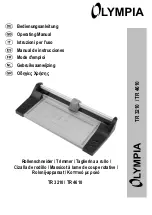
Page 9
OPERATION
WARNING:
Always wear safety goggles or safety glasses with side
shields when using your trimmer. Failure to do so could
result in dust, shavings, chips, loose particles, or foreign
objects being thrown into your eyes resulting in possible
serious injury. If the operation is dusty, also wear a face
or dust mask.
WARNING:
When turning your trimmer ON, be prepared for start-up
torque. Always have a firm grasp of your trimmer before
starting. Because of the high cutter speed rotation your
trimmer has a tendency to twist, jerk, or grab in your hands
during start-up. If not prepared, this can cause a loss of
control resulting in possible serious injury.
HOW TO OPERATE YOUR TRIMMER
Before starting your trimmer, unplug it and make sure cutter
is securely tightened in collet and that depth of cut is properly
set. Never start trimmer while cutter is in contact with the
workpiece.
After completing a cut, pull cutter slightly away from cut
surface. Turn trimmer off and wait for rotating cutter to
completely stop before removing base from work surface.
Your trimmer is turned on by means of a slide switch located
on top of the tool. Make a few cuts on a piece of scrap
material to determine the desired depth or shape of cut.
When cutting, fit the base of your trimmer over the work
surface and firmly hold the body of your trimmer with your
hand. Make sure the trimmer is running at full speed. For best
results, move your trimmer from left to right, against the
turning direction of the cutter.
See Figure 5. Be sure not to
move trimmer too rapidly.
Remain alert and watch what you are doing. DO NOT
operate trimmer when fatigued or under the influence of
drugs, alcohol, or any medication.
FEED DIRECTION
When trimming, the cutter rotates clockwise. Therefore, you
should feed the trimmer into the workpiece from left to right.
When fed from left to right, the rotation of the cutter pulls the
trimmer against the workpiece. If fed in the opposite direc-
tion, the rotation forces of the spinning cutter will tend to
throw the trimmer away from the workpiece. This could
cause loss of control of your trimmer.
RATE OF FEED
IMPORTANT: The whole “secret” of professional laminate
trimming lies in making a careful setup for the cut to be made
and in selecting the proper rate of feed.
The proper rate of feed depends on several factors: the hard-
ness and moisture content of the workpiece, the depth of
cut, and the cutting diameter of the cutter. When cutting shal-
low grooves in soft woods such as pine, a faster rate of feed
can be used. When making cuts in hardwoods such as oak,
a slower rate of feed will be required.
The best rate of feed is one that does not slow down the
trimmer motor more than one-third of its no-load speed. If
the trimmer is fed too fast, it will take large chips out of the
wood and leave gouge marks. If the trimmer is fed too slow,
it will scorch or burn the wood.
PROPER FEEDING
The right feed is neither too fast nor too slow. It is the rate at
which the cutter is being advanced firmly and surely to pro-
duce a continuous spiral of uniform chips or a smooth trim
edge on laminate. If you are making a small diameter, shal-
low groove in soft, dry wood, the proper feed may be about
as fast as you can travel your trimmer along your guide line.
On the other hand, if the cutter is a large one, the cut is
deep or the workpiece is hard to cut, the proper feed may
be a very slow one. A cross-grain cut may require a slower
pace than an identical with-grain cut in the same workpiece.
There is no fixed rule. You will learn by experience from
practice and use. The best rate of feed is determined by
listening to the sound of the trimmer motor and by feeling
the progress of each cut. Always test a cut on a scrap piece
of the workpiece wood or laminate beforehand.
FORCE FEEDING
Clean, smooth laminate trimming and edge shaping can be
done only when the cutter is revolving at a relatively high
speed and is taking very small bites to produce tiny, cleanly
severed chips. If your trimmer is forced to move forward too
fast, the speed of the cutter becomes slower than normal in
relation to its forward movement. As a result, the cutter must
take bigger bites as it revolves. “Bigger bites” mean bigger
Fig. 5
































